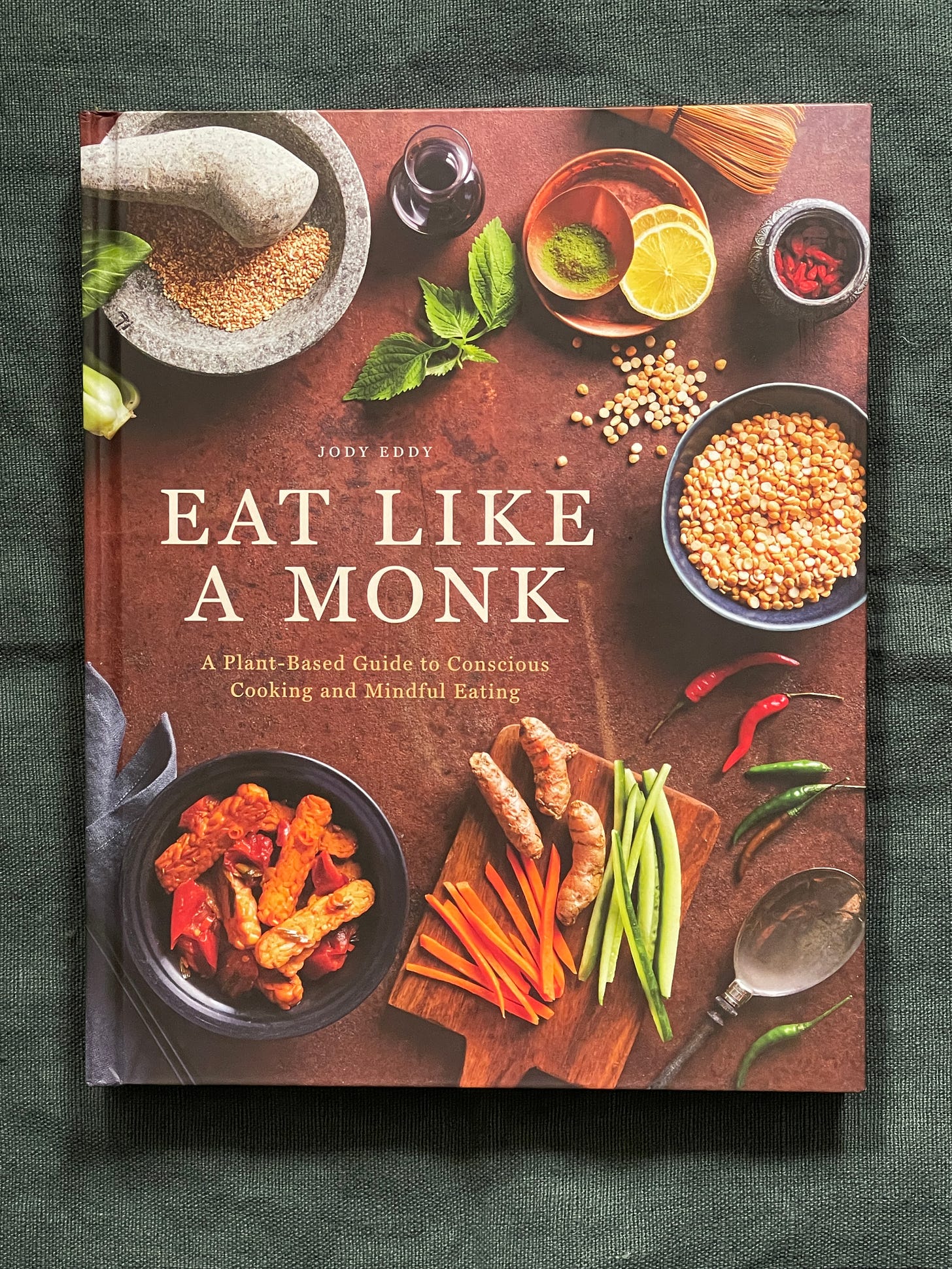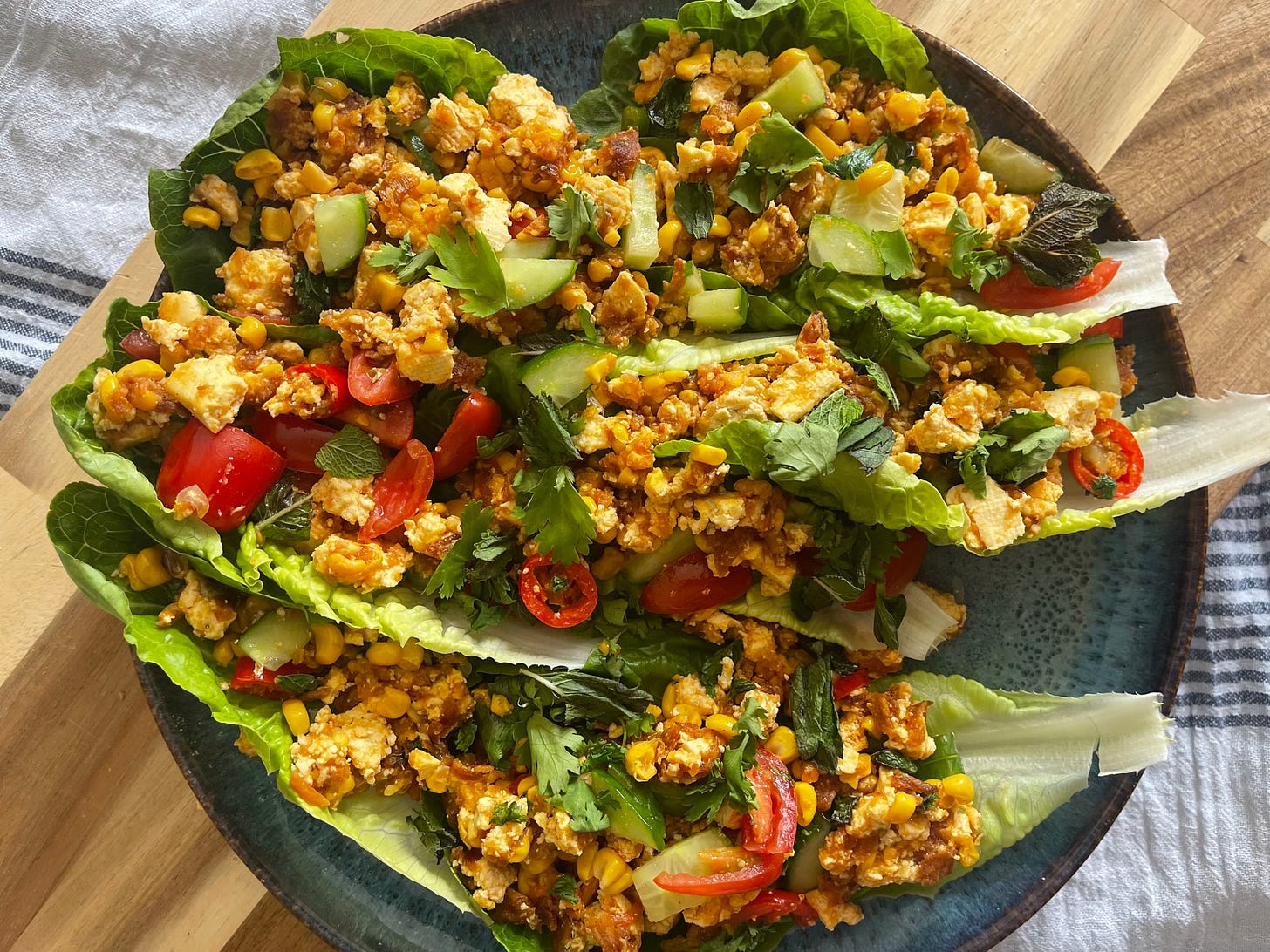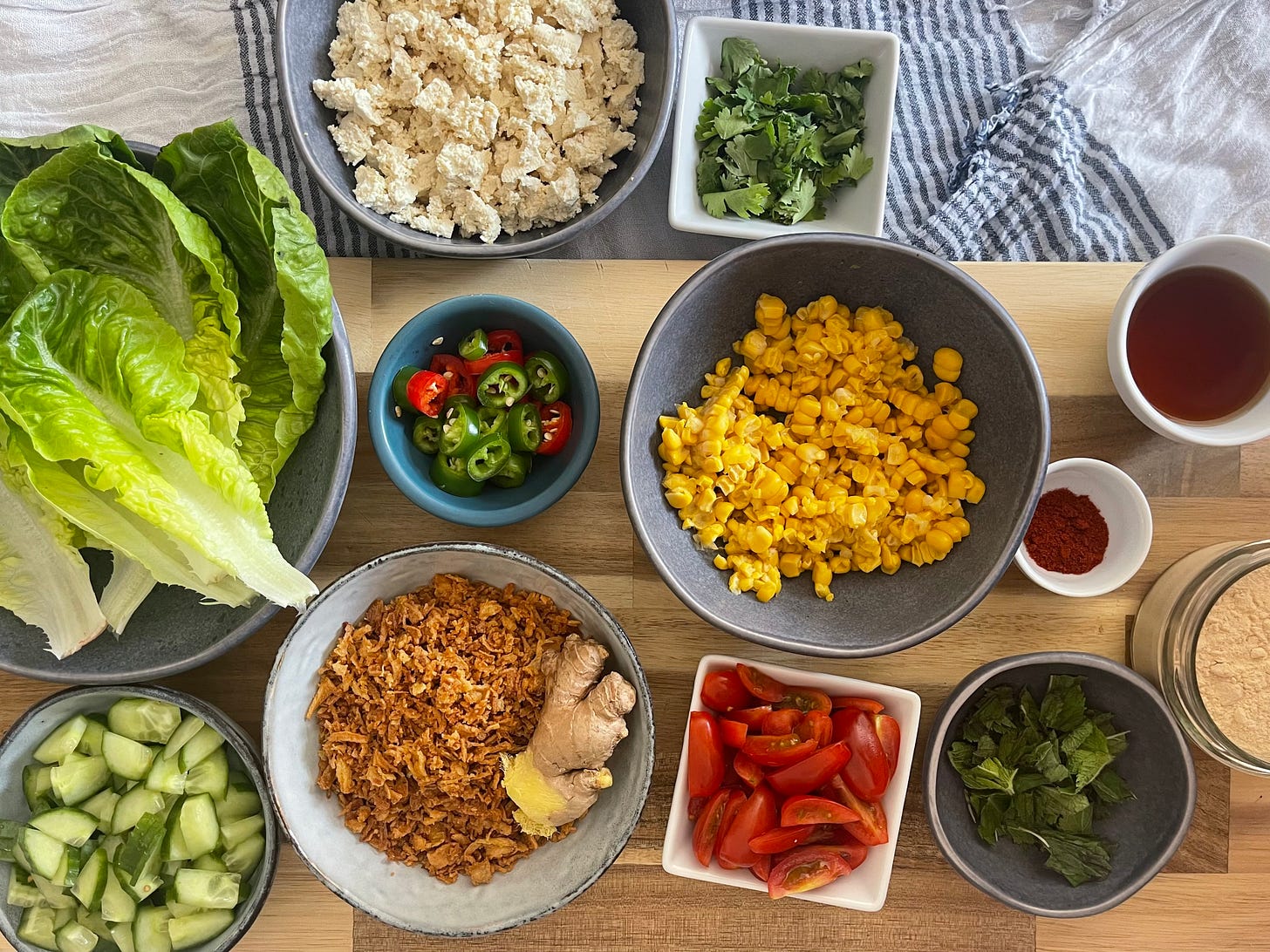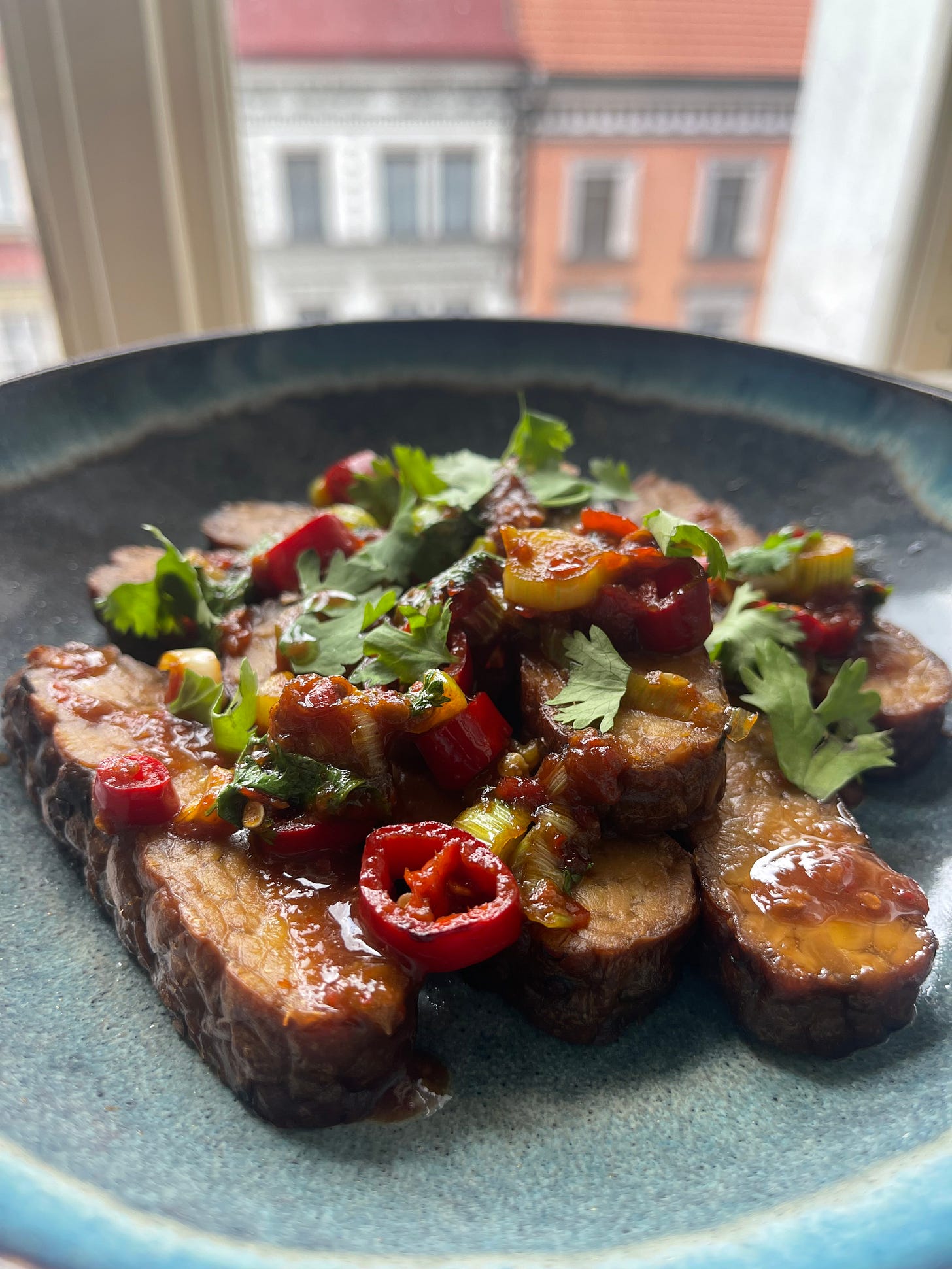Eat Like a Monk: My Cookbook About Plant-Based Monastic Cooking
with two of my favorite recipes from the book
Welcome to What’s Good Here, a weekly newsletter of recipes, guides, inspiration and expat news. Thank you for being here! This post is free, so please feel free to share it with the food and travel lovers in your life. What’s Good Here is a reader-supported endeavor. To support this publication and to gain access to all recipes, guides, giveaways and other perks, please consider becoming a subscriber. Thank you!
I'm excited to share my most recent cookbook with you: Eat Like a Monk: A Plant-Based Guide to Conscious Cooking and Mindful Eating, from Simon & Schuster. While my other recent cookbook Elysian Kitchens: Recipes Inspired by the Traditions & Tastes of the World’s Sacred Spaces explored the culinary traditions of monasteries, temples, synagogues and mosques all over the world, this book takes a more focused approach by celebrating the vibrant plant-based cuisines found in Buddhist temples across East, Southeast, and South Asia.
Elysian Kitchens was truly a global adventure—a culinary travelogue that traversed continents, documenting recipes from Catholic monasteries in Quebec, France, Ireland, Spain, and Minnesota, a Maronite monastery in Lebanon, an Orthodox community in Brooklyn, a Sikh gurudwara in New Delhi, a Tibetan Buddhist monastery in the Indian Himalayas, a Zen Buddhist temple in Japan, and a Sufi zawiya in Fes, Morocco. It invites readers and cooks to journey alongside me as I explored how culinary traditions manifest in kitchens across different cultures, geographies and religious practices.
Eat Like a Monk, by contrast, offers something more focused and just as urgently needed in today's tumultuous world—a contemplative guide to finding inner equilibrium through the wisdom of Asian temple cuisine. Rather than breadth, this book delves deeper into a single tradition, extracting timeless practices that serve as a compass for navigating our increasingly chaotic lives. It offers practical pathways to cultivating tranquility, mindfulness, and balance through our relationship with food.
Though I'm not strictly plant-based in my own diet, creating this cookbook was a revelation. Testing these 50 recipes and exploring the traditions of the different locations and spiritual practices brought an unexpected sense of calm, vitality, and contentedness into my kitchen. I was inspired by the vivid colors, bold flavors, and relative simplicity of these dishes that have nourished Buddhist monks for centuries.
I hope what makes this cookbook special isn't just the bright and nourishing recipes—it's the timeless wisdom woven throughout these culinary traditions. In our increasingly uncertain world, the principles that guide monastic cooking offer valuable lessons about living with intention, gratitude, and harmony.
I was happy to see that Eat Like a Monk was featured in Plant Based News this week, which shared two of my favorite recipes from the book. They highlighted the Chana Masala, a protein-rich Indian chickpea stew that perfectly embodies the principles of balance and simplicity, as well as Zhi Ma Jiang Huang Gua (Pickled Sesame Cucumbers), refreshing pickles from China that reflect the monks' deep respect for preservation techniques and clean, vibrant flavors. These dishes beautifully demonstrate how monastic temple cuisine transforms humble ingredients into colorful, nourishing meals without unnecessary complexity or expense.
At the end of this post, I’m also sharing two recipes with you from Eat Like a Monk including Larb Jay from Thailand and Sambal Goreng Tempeh from Indonesia. I hope you enjoy!
More Than a Cookbook: Ancient Wisdom for Modern Times
Eat Like a Monk explores eight fundamental principles that infuse monastic cooking traditions. Each chapter delves into one of these guiding philosophies:
Asceticism and Moderation - Finding contentment through simplicity and restraint
Food as Medicine - Harnessing the healing power of ingredients
Seasonality - Aligning with nature's rhythms and cycles
Ritual and Routine - Finding peace through mindful food practices
Sustainability - Respecting the earth and minimizing waste
Flavor, Color, and Preservation - Creating vibrant, healthy meals that celebrate the senses
Balance and Simplicity - Achieving harmony through uncomplicated approaches
Mindfulness, Respect, and Gratitude - Cultivating awareness and appreciation in the kitchen
These principles aren't just about making better food—they're about creating a more intentional relationship with everything we eat, from cultivation to preparation to consumption.
Temple Wisdom for Today's World
The Buddhist approach to food feels particularly relevant in our current times. As we navigate global uncertainty, information overload, and ecological challenges, these ancient practices offer practical guidance:
Combatting Overwhelm: The focus on simplicity and moderation provides an antidote to our culture of excess
Finding Center: Ritual and mindfulness practices help ground us amid chaos
Environmental Harmony: Sustainable approaches remind us of our connection to the planet
Physical Wellbeing: Plant-based, whole-food recipes support vibrant health
Mental Clarity: Mindful cooking and eating reduce stress and increase presence
As one Buddhist monk eloquently stated, "In the pursuit of learning, every day something is acquired. In the pursuit of the Tao, every day something is dropped." These monastic kitchens remind us that sometimes, the path to fulfillment comes through simplification rather than accumulation.
A Culinary Journey Through Asia's Temple Traditions
The 50 recipes in "Eat Like a Monk" span countless territories and traditions across Asia. Here are a few highlights:
Kongnamul Muchim (Korea) - A refreshing bean sprout salad that embodies Korean monks' commitment to moderation with bright, clean flavors
Phở Chay (Vietnam) - A spirit-warming vegetarian noodle soup that transforms simple ingredients into a complex, aromatic bowl of comfort
Fan Tuan (Taiwan) - Colorful rice balls that provide Taiwanese Buddhist monks with a nutritional boost while offering a delightful eating experience
Suutei Tsai (Mongolia) - A salted green tea with plant-based milk that provides warmth and nourishment during Mongolia's frigid winters
Kichari (India) - A soothing rice and yellow split pea porridge considered medicinal in Ayurvedic traditions for its easy digestibility
Som Tum Jay (Thailand) - A vibrant green papaya salad that celebrates Thailand's tropical bounty with a perfect balance of sweet, sour, and spicy
Lian Zi Zhou (China) - A lotus seed congee symbolizing spiritual growth, mirroring the lotus plant's journey from mud to beautiful blossom
Banh Bot Loc (Vietnam) - Translucent dumplings steamed in banana leaves that showcase the Vietnamese reverence for nature and sustainability
Dal Shorba (India) - A warming lentil soup that demonstrates how humble ingredients can create deeply satisfying nourishment
Miyeok Muchim (Korea) - A sweet and tangy kelp noodle salad rich in minerals and representing Korea's deep connection to the sea
Essential Kitchen Wisdom from the Monasteries
Throughout the book, you'll find sidebars offering deeper insights into monastic life and cooking philosophy:
The Middle Path: Finding balance between extremes in cooking and life
Avoiding Foods with Strong Flavors: Why monks often eschew certain intense ingredients
The Interplay of Color, Meditation, and Culinary Artistry: How visual beauty enhances mindfulness
Fermentation and Food Preservation: Ancient techniques for nutrition and sustainability
Buddhist Symbols: The deeper meanings behind common motifs in temple cuisine
Temple Dining: The experience of sharing meals in a sacred space
These teachings aren't just historical curiosities—they're practical approaches that can transform your relationship with food and cooking.
Final Thoughts: Finding Sacred Space in Your Kitchen
Perhaps what I appreciate most about monastic cooking traditions is how they can transform everyday practices into something that feels a bit more sacred. The kitchen becomes a place of meditation and rituals, ingredients become gestures of gratitude, and meals become opportunities for connection and presence.
As we navigate our complex modern lives in this increasingly confusing world, these ancient practices remind us that nourishment goes beyond calories and nutrients. By embracing even a few of these monastic principles, we can bring greater intention, joy, and harmony to our tables.
Eat Like a Monk is available from Simon & Schuster or find it at your favorite independent bookstore, including one of my favorites, Shakespeare & Company in Paris, or pick it up at the library including Brooklyn Public Library.
I'd love to hear which recipes and principles resonate most with you!
News & Favorites
Elysian Kitchens: Published in October by W.W. Norton, it’s available online as well as in many independent bookstores. It’s appeared on The Splendid Table, Saveur, the Food with Mark Bittman podcast and many other places. If you’ve picked up a copy and enjoyed it, I’d be so grateful if you’d consider leaving a review—they truly help. There will be more news and behind-the-scenes stories about Elysian Kitchens in the coming months, along with an event series inspired by the book that kicks off in Minnesota, Ireland, Italy and Portugal in fall 2025, . More info will be available in my post next week.
London Writer’s Salon: A recent conversation I had with the London Writer’s Salon about cookbook writing and my career in the culinary world is now available on any of the major podcast platforms including Apple and Spotify. I love the work of the LWS, a global writing community that has provided me with the encouragement, tools and conversations I’ve needed to complete my first novel. More on that soon!
Summer Kitchens by Ukrainian chef and food writer Olia Hercules: In light of the punishing news cycle surrounding Ukraine right now, it feels like the right time to revisit Summer Kitchens by Olia Hercules—a love letter to the country’s rich culinary traditions, rooted in the communal practice of building community through the love of food. The book explores the significance of letni kuchni, the rustic outdoor kitchens found in Ukrainian villages, and offers a deep dive into seasonal, home-cooked dishes like fermented tomatoes, garlicky pampushky, and buckwheat honey cake. Olia, a fierce advocate for Ukrainian culture and a celebrated chef, has long used food as a means of storytelling and resistance. Her forthcoming book, Strong Roots, available for preorder now and published in June, 2025, continues this mission, weaving together personal history, the resilience of Ukrainian cuisine, and the power of food to preserve identity.
I am a drop in the ocean, but without me, the ocean would be smaller.
— Lesya Ukrainka, Ukrainian poet, playwright, and activist
My newsletter is reader-supported.
Free subscribers get limited access to the weekly newsletter and two weeks worth of archives.
Paid subscribers get complete access to all of the content in my newsletters and my entire archives. You’ll also get all of the recipes, guides, interviews, cooking tips, essays and more, plus the ability to comment and participate in discussions.
In 2025, I will be offering my standard hygge workshops along with new workshops on cookbook writing, becoming an expat and more. Paid subscribers will receive a 50% discount on their first course. More info coming soon.
Newsletters will arrive right in your Inbox or you can read them through the app.
The following recipes are from Eat Like a Monk but the photos are those I captured during the recipe development and testing process for the book.
Larb Jay (spicy minced tofu salad from Thailand)
Larb, a flavor-packed meat salad that is often regarded as the national dish of Laos, also enjoys immense popularity in Thailand, especially in the northeastern region, known as Isan. Larb jay or vegetarian larb is a plant-based version of this dish, embodying the colors, textures, and flavors in a vibrant salad that is packed with flavor and nutritional benefits.
For Thai Buddhist monks, this dish, like all food, is seen as not only a form of physical sustenance but also a means of spiritual nourishment. It’s a reflection of the Buddhist principles of mindful eating and the interconnectedness of all beings. The simple act of preparing and consuming food is seen as an opportunity for mindfulness and appreciation of the present moment. This delightful recipe exemplifies the amalgamation of colors, textures, and flavors, each bite offering a tasty blend of tangy, sweet, spicy, and umami. Challenge yourself to experiment with this recipe, guided by the bounty of the season. The rainbow of colors signifies the beauty of nature, diversity, and life itself. It’s a wonderful dish for enticing a crowd who will come for the colors and stay for the flavors.
This recipe calls for khao khua, or roasted rice powder, which acts as a thickening agent for the tofu, imparting a silken texture and subtly nutty flavor. Khao khua is available at Asian specialty markets. If you can’t find it, don’t worry. Larb jay is just as delicious without it. Or if you would like to make your own, toast uncooked sticky rice in a dry pan until golden, let cool, and then grind into a coarse powder using a mortar and pestle or a spice grinder. It will keep in a covered container at room temperature for up to 3 weeks.
Serves: 4
Prep & Cook Time: About 30 minutes
Ingredients:
1 tablespoon vegetable oil
1 cup (225 g) crumbled firm tofu
1 cup (170 g) fresh corn kernels
1/2 cup (85 g) quartered cherry tomatoes
2 tablespoons khao khua
1 tablespoon low-sodium soy sauce
1 tablespoon vegan fish sauce
Juice of 2 limes
1 tablespoon dark brown sugar
2/3 cup (100 g) sliced cucumbers
1/2 cup (15 g) loosely packed mint leaves
1/2 cup (15 g) loosely packed cilantro leaves
3 heads Little Gem lettuce, leaves separated, for serving
In a pan, heat the oil over medium heat. Add the tofu and sauté until it begins to turn golden brown, about 5 minutes. Add the corn kernels and sauté until they are slightly charred, about 10 minutes. Reduce the heat to low and stir in the tomatoes. Sauté until they begin to soften, about 3 minutes. In a small bowl, stir together the khao khua, soy sauce, fish sauce, lime juice, and brown sugar until incorporated. Stir into the pan and cook until the sauce begins to thicken, about 5 minutes. Remove from the heat and mix in the cucumbers, mint, and cilantro.
To serve, arrange the lettuce cups on a serving platter and spoon the larb jay into them. Serve immediately. Larb jay doesn’t keep very well because the ingredients will become soggy when refrigerated. It’s best to enjoy right away!
Different Tofu Varieties:
Tofu, also known as bean curd, is a versatile food derived from soybeans. It’s available in various types and consistencies, which makes it suitable for a wide range of plant-based dishes, from savory to sweet. Different types of tofu are suitable for various dishes and culinary applications, so it’s beneficial to choose the right type for each recipe to achieve the desired texture and flavor outcome.
Here are some common types of tofu:
Silken Tofu: This type has a creamy, custard-like texture and is usually used in desserts, smoothies, soups, or salad dressings.
Soft Tofu: Slightly firmer than silken but still delicate, soft tofu is often used in soups like miso or in gentle simmered dishes.
Medium Tofu: This has a denser texture than soft tofu but is not as hard as its firm counterparts. It can be crumbled and used in various dishes.
Firm Tofu: This tofu holds its shape well, making it suitable for frying, sautéing, grilling, or stir-frying. It can be easily marinated because it absorbs flavors well.
Extra-Firm Tofu: With the least amount of moisture among the firm tofu varieties, extra-firm tofu has a very dense texture. It’s ideal for grilling, stir-frying, or any cooking method that requires the tofu to maintain its shape.
Sprouted Tofu: Made from sprouted soybeans, this tofu is believed to be more nutritious and digestible than tofu made from non-sprouted soybeans. Its texture is similar to firm or extra-firm tofu.
Smoked Tofu: As the name suggests, this tofu has been smoked, providing it with a distinct flavor and darker outer layer. It’s ready to eat out of the package and can be added to salads, sandwiches, or other dishes.
Fermented Tofu: This type of tofu undergoes fermentation, resulting in a strong flavor. There are various types of fermented tofu, such as stinky tofu and tofu cheese.
Tofu Skin (Yuba): As soy milk is heated, a skin forms on its surface, which can be harvested as yuba. It can be used fresh or dried in various dishes, from soups to wraps.
Sambal Goreng Tempeh (spicy fried tempeh from Indonesia)
Sambal goreng tempeh is a lovely embodiment of the Buddhist commitment to sustainability. It includes tempeh, a fermented soybean product, effectively showcasing the Buddhist principle of turning simple, earth-friendly ingredients into delicious, nourishing meals. Buddhist monks in Indonesia embrace this dish, as tempeh is a rich protein source, a critical nutrient that is often challenging to integrate adequately into plant-based diets. The use of soybeans, a legume that replenishes the soil it grows in, embodies the Buddhist commitment to life’s cyclical nature and sustainability.
Originating from Java, Indonesia, where tempeh is a staple, the dish’s roots tie closely to the place where tempeh is believed to have been invented several centuries ago, a testament to long-standing sustainability practices. There are many variations to sambal goreng tempeh, particularly in the type of sambal used. Sambal is a spicy chile-based condiment or sauce that is widely popular in Indonesia, Malaysia, Singapore, the southern Philippines, and other Southeast Asian countries. It’s a versatile element in many dishes and can also be served as a side to enhance the flavors of meals. Its primary ingredient is chiles, which can range from mild to extremely hot varieties. While some prefer it with sambal terasi (fermented shrimp paste), others lean toward the tang of sambal hijau (green chile sambal). A plant-based alternative would be a sambal made with fermented soybeans or tomatoes.
Serves: 4
Prep & Cook Time: About 30 minutes
Ingredients:
2 tablespoons vegetable oil
3/4 lb (340 g) tempeh, cut into 12 pieces
4 Roma tomatoes, coarsely chopped
2 red chiles, thinly sliced
2 green onions, thinly sliced
2 tablespoons tamarind paste
11/2 tablespoons vegan fish sauce
1 tablespoon dark brown sugar
2/3 cup (180 ml) water
Cilantro leaves, for garnish
Cooked rice, for serving (optional)
Line a plate with paper towels. Heat the oil in a pan over medium-high heat and fry the tempeh until it turns golden brown, about 3 minutes per side, flipping once using tongs. Transfer the tempeh to the plate to drain. Add the tomatoes, chiles, and green onions to the pan and sauté until tender and aromatic, about 3 minutes. In a small bowl, whisk together the tamarind paste, fish sauce, sugar, and water until the sugar is dissolved and stir into the pan.
Add the tempeh and spoon the sauce over it. Reduce the heat to low and gently simmer until the tempeh has absorbed the sauce and the flavors have had an opportunity to mingle, about 10 minutes. If the sauce becomes too thick during this step, add water, 1 tablespoon at a time, to loosen it up. Remove from the heat and transfer to warm plates. Garnish with cilantro and serve with rice, if desired. It will keep in a covered container in the refrigerator for up to 3 days.
Expat Life: Advice, Tips, News and Encouragement
I relocated from America to Europe about four years ago and I’m always being asked what the experience has been like, how to do it, advice for making the process easier, and where to live.
It’s tricky, sometimes headache inducing, often nerve wracking, a bit baffling, but not impossible and at least for me, fulfilling, rewarding, and life enhancing. This weekly section explores what I’ve learned (and am continuing to learn) and highlights the most recent news and helpful advice for those who are thinking about exploring the expat life.
In this week’s edition of Expat Life: Upcoming Workshops About Becoming an Expat
My life as an American immigrant in Europe continues to shape my perspective on food, culture, and community. I'm excited to announce that in a few weeks, I'll be launching comprehensive courses covering everything you need to know about becoming an expat in the countries where I have secured long term residency including The Czech Republic, Spain and Portugal. Whether you're considering a temporary adventure or a permanent relocation, these resources will help navigate the practical, logistical, and emotional aspects of international living.
I've noticed a significant uptick in Americans reaching out to me recently with questions about this process. If you're considering making the leap yourself and would like personalized guidance, I'm available for one-on-one consultations for a minimal fee. Simply email me at jodyeddy@gmail.com or send a private message through Substack, and we can arrange a time to discuss your specific situation and questions.
Let’s Talk!
Please join the What’s Good Here community by posting a comment or to just say hello to get the conversation started!
Image attributions throughout the newsletter are mine, unless otherwise noted.
If you would like to learn more about me and discover what I will deliver to you each week through this newsletter, you can find that information here or check out my Instagram or website.





